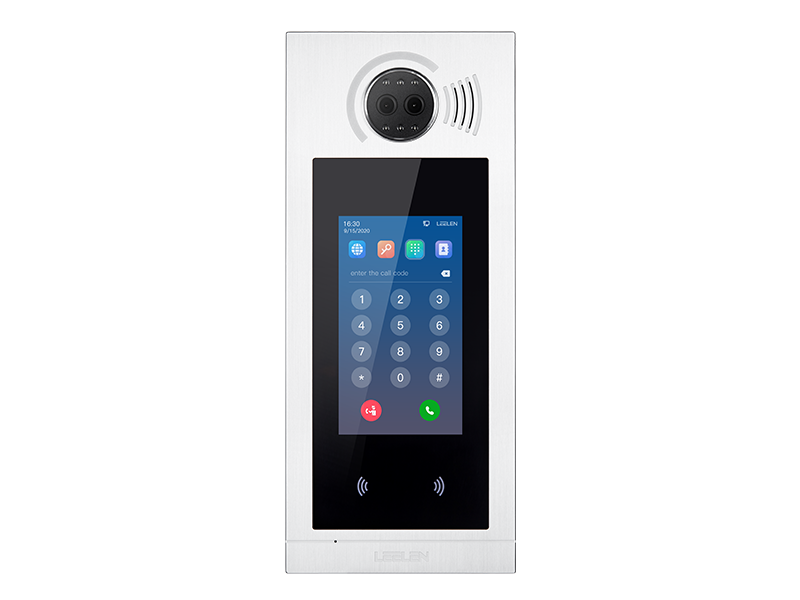Remote Gate Intercom: Smart Home Upgrade Solution
Abstract
In the field of smart home security, remote gate intercom has redefined home access management through the integration of cloud technology and mobile terminals. This article analyzes how remote gate intercom breaks through distance limitations and achieves real-time security response and non-sensitive intelligent control from the perspective of technical architecture, scene adaptation to future evolution.
Core technology analysis of remote gate intercom
Remote gate intercom relies on encrypted networks (such as TLS 1.3 protocol) and low-latency audio and video codec technology (such as H.265) to ensure real-time image transmission and privacy protection. Taking the Aiphone GT series as an example, it adopts a dual-channel communication design: the main line is based on optical fiber to transmit 4K video, and the backup 4G network ensures that alarm information can still be pushed to the mobile phone App when the network is disconnected. The addition of edge computing chips (such as HiSilicon Hi3559) supports local face recognition and license plate capture, reducing cloud dependence.
Three key points to choose remote gate intercom
Network compatibility: Devices that support Wi-Fi 6 and 5G dual-mode (such as 2N® IP Verso) can cope with complex network environments and reduce the freeze rate to less than 0.1%.
End-to-end encryption: Choose products that have passed FIPS 140-2 certification (such as Comelit 6746W) to prevent data hijacking and man-in-the-middle attacks.
Cross-platform linkage: Models that support Apple HomeKit or Google Home integration (such as Ring Elite Pro) can synchronize visitor records to the home control screen with one click.
Smart scene application of remote gate intercom
Through the API interface, remote gate intercom can deeply link with the smart home system:
Unattended scene: When the courier presses the doorbell, the system automatically calls the camera to capture and generate a temporary pickup code, which is sent to the user's mobile phone via SMS.
Multi-property management: With the help of private cloud platforms (such as Dakota Alert Cloud), users can simultaneously monitor the access control status of villas, apartments and other locations.
Voice interaction optimization: For example, Bticino MyHome App supports dialect recognition, and elderly users can directly use spoken commands (such as "open the downstairs door") to remotely release visitors.
Installation and Security Maintenance Guide
Network segmentation isolation: Deploy the access control system in an independent VLAN to limit the access rights of external devices.
Two-factor authentication: Enable biometrics (such as fingerprints) and dynamic verification codes for dual login verification.
Automatic firmware update: Enable the OTA function of IoT devices (such as Hikvision HiDDNS service) to ensure that vulnerabilities are fixed in time.
Future trend: AI-driven remote access control innovation
The next generation of devices will integrate generative AI and behavioral analysis algorithms:
Intention prediction: Through visitor movement trajectory analysis (such as wandering detection), the system pushes early warning notifications in advance.
Virtual identity generation: AI automatically generates temporary virtual faces (such as Apple Face ID dynamic masks) to replace traditional password authorization.
Carbon footprint optimization: Using solar power modules (such as Axis Q3538-LVE) can reduce the standby power consumption of equipment by 67%.
Summary
Remote gate intercom has achieved a leap from "passive response" to "active warning" in security through cloud collaboration and intelligent algorithms. Selecting highly secure and highly compatible devices and optimizing network architecture and maintenance strategies can maximize their value in smart homes.
FAQ
Q1: Will remote gate intercom become invalid after network disconnection?
A: High-end models have built-in 4G/5G redundant modules, which can automatically switch to mobile networks when the network is disconnected and trigger local storage of emergency videos.
Q2: Does the device support simultaneous remote access by multiple people?
A: It supports hierarchical management of multi-user permissions. For example, owners, property management, and housekeeping staff can obtain different levels of operation permissions.
Q3: Can remote gate intercom be installed in old communities?
A: You can reuse the original lines through a PoE adapter (such as Ubiquiti UACC-PoE-48-24G) without having to re-dig trenches for wiring.

